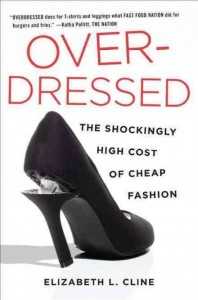![]()

I’m a bit late to the party reading Overdressed: The Shockingly High Cost of Cheap Fashion by Elizabeth L. Cline, but it moved me so much I wish I’d read it sooner. The book raises valid points about the trouble with our American culture and how we view/shop for clothing. We have become mega-consumers of low-quality goods, creating a huge waste problem.
“The most general consumer would rather buy the cheap stuff because they don’t want their clothing the next season. They will spend $20, so they can buy sixty or one hundred pieces, but they will not spend $150 dollars [on one garment yet buy fewer pieces]. It’s very wasteful,” says Alan Ng, a Brooklyn garment factory manager.
Admit it: You’ve probably taken perfectly good clothes and tossed them in the trash at some point. But do you think of the ignored clothes in the back of your closet as a garbage problem?
“In the spring of 2011, H&M launched the Conscious Collection, a line of clothing made from recycled plastic and organic. Two weeks later the Web site was promoting summer shorts and knits. I e-mailed H&M’s PR person and told them that, in my humble opinion, sustainable design and the high-volume production … seemed to be opposing design approaches. How do you reconcile the two? I received this fascinating exercise in doublespeak in response: ‘We do not believe that low prices can be equated with a throwaway society, because price and the life span of a garment are not related to each other … H&M offers fashion and quality at the best price … and we take responsibility that our products will be manufactured in an environmentally, socially, and economically sustainable way.”
I remember seeing the Conscious Collection campaign and tweeting that it was totally BS. It seemed so obvious that H&M saw ‘sustainable’ and ‘green’ as buzzwords to use in their marketing. H&M is the furthest thing from green or sustainable; they are contributing to the problem by pumping new goods into the market at an alarming rate.
As a personal stylist, I feel that it’s my duty to educate my client as to what is worth buying and what is crap, and I have refused clients who demand to shop at fast-fashion stores and Macy’s. I would hate to have a client spend money with me to buy a whole new wardrobe only to have it fall apart in a season or two.
“We are all stewards of our clothing, responsible for seeing it through its different phases of life. Even if we don’t have any use for a piece of clothing, it’s up to us to make sure its next stop in the clothing life cycle isn’t the landfill. Clothing should be kept in good condition, able to be worn after us, which means caring for and maintaining it while we own it and cleaning it and repairing it before we donate it or sell it or give it away.”
As a consumer, what can you do to practice conscious spending and reduce your waste? Here are some tips to make sure you waste not, want not in style:
-
Download my style podcast to feel confident that all purchases going forward really suit you.
-
Save up for better quality items which will get multiple uses.
-
Avoid buying lots of items just because they are cheap.
-
Stay away from H+M, Zara, Old Navy, and other fast-fashion quick fixes. Only purchase versatile, well-constructed that you know you will wear for years to come.
-
Only buy what you need. Make a list of what you need while sorting through your closet and don’t stray from it when in stores.
-
Look in department stores, which tend to carry better quality goods.
-
Learn to spot quality work. Check out linings, fabric content, and where the garment was made.
-
Decide for yourself if you want to purchase clothing from China. I bet you will be surprised how much in your closet is from China, Vietnam, and India.
-
Explore alternative options like made-to-measure clothes from Etsy vendors. They are more reasonably priced than you think.
-
Come to terms with the fact that quality is NOT cheap. Get over it. Clothing is worth investing in!
“Clothing companies have enjoyed decades of cheap foreign labor and the resulting profits, but what exactly are the tangible benefits to us, the American consumer? We own more clothing than we can wear, the quality and craftsmanship of our wardrobes are at an all-time low, and the U.S. manufacturing base can’t compete on wages with the developing world, costing countless domestic jobs.”
Additional relevant posts:
Want to learn more about what to spend on and what to splurge on?
http://alexandrastylist.com/
Practical tips based on how I think and act green:
http://alexandrastylist.com/



 She helped me create not just outfits but a style statement for how I go out in the world in the morning. She’s given me a new sense of confidence, especially when I go to professional meetings
She helped me create not just outfits but a style statement for how I go out in the world in the morning. She’s given me a new sense of confidence, especially when I go to professional meetings